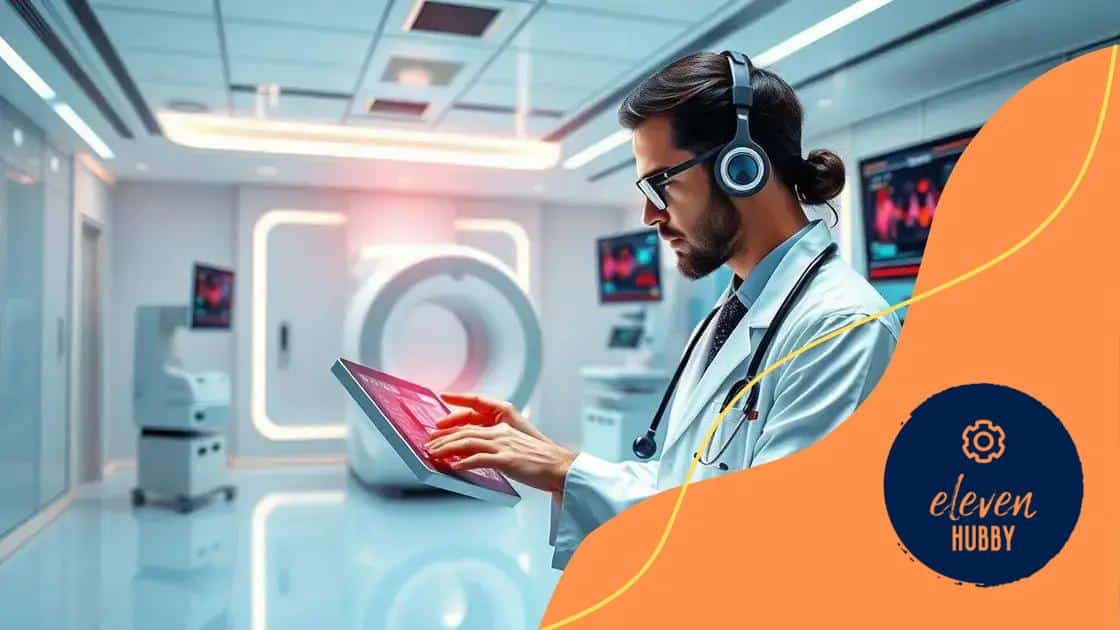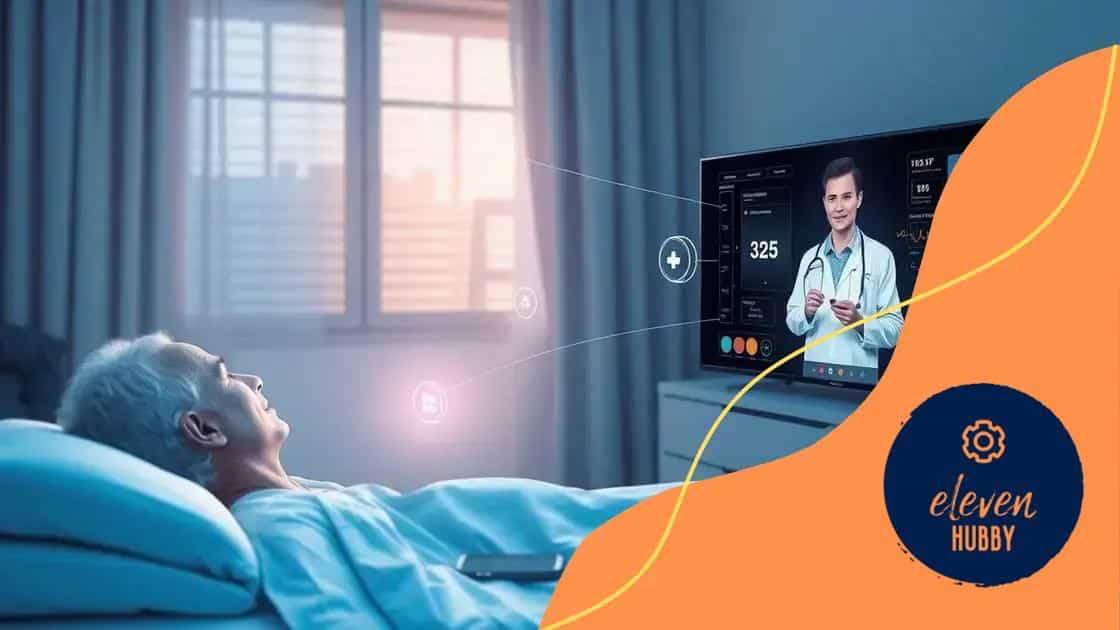The role of 5G in transforming smart healthcare systems

The role of 5G in transforming smart healthcare systems enhances patient monitoring, telemedicine, and data transfer, leading to improved patient engagement and outcomes through advanced technology.
The role of 5G in transforming smart healthcare systems is becoming increasingly vital. Have you considered how this technology might change your health experience? Let’s explore its potential together.
Understanding 5G technology
Understanding 5G technology is crucial for grasping its role in healthcare. This advanced network promises faster data speeds and improved connectivity that can truly change how we manage health.
5G is the fifth generation of mobile networks, and it’s not just about speed. With lower latency and the ability to connect many devices simultaneously, 5G enhances communication between medical devices, practitioners, and patients.
Key Features of 5G
Here are some important features that set 5G apart:
- Enhanced speed: 5G offers speeds up to 100 times faster than 4G.
- Lower latency: This means quicker response times for applications.
- Wider bandwidth: Supports more devices connecting at once.
- Increased reliability: Strengthening connections in critical applications.
These features are especially beneficial for telemedicine and remote monitoring. For instance, doctors can receive real-time updates from wearable devices, improving patient care. Moreover, hospitals can manage resources through smart equipment connected via 5G networks.
Think about surgeries performed remotely; with 5G, surgeons can operate robotic instruments with high precision while being miles away from the patient. This technological leap changes the game for healthcare, particularly for rural communities where specialists may be scarce.
The implications of adopting 5G are enormous. Imagine real-time diagnostics, seamless data transfer, and improved patient monitoring. With such advancements, healthcare not only becomes more effective but also more accessible. This is how 5G technology is paving the way for a smarter, more efficient healthcare system.
How 5G enhances telemedicine
How 5G enhances telemedicine is a crucial topic in today’s healthcare landscape. With the advancement of technology, telemedicine has evolved significantly, and 5G is at the forefront of this transformation.
The reliability and speed offered by 5G networks allow healthcare providers to deliver consultations and treatments remotely with ease. Imagine a patient in a rural area receiving expert care without traveling long distances. 5G technology makes this possible by enabling high-quality video calls and fast data transfers.
Benefits of 5G in Telemedicine
Here are some distinct improvements brought by 5G:
- Improved video quality: 5G enhances video consultations, making them clearer and more effective.
- Faster data transfer: Patient records can be shared swiftly, allowing for quicker decision-making.
- Support for remote monitoring: Devices can continuously transmit data, giving doctors real-time insights.
- Better access to specialists: Patients can connect with specialists without delay, regardless of location.
This means better monitoring for patients with chronic conditions. For example, doctors can track heart rates or blood sugar levels in real-time, quickly adjusting treatments if needed. Also, 5G can facilitate remote surgeries with robotic systems controlled by surgeons from miles away, making tricky procedures more accessible to patients everywhere.
Furthermore, imagine using augmented reality during telemedicine consultations. A doctor could guide a patient through a procedure step-by-step, enhancing understanding and compliance. As telemedicine evolves with 5G, patient care becomes more personalized and effective.
The advent of 5G in telemedicine will not only speed up responses but also reduce healthcare costs. More patients will access care, leading to earlier interventions and better outcomes. With the world shifting towards digital solutions, 5G’s role in telemedicine is undoubtedly pivotal in shaping the future of healthcare delivery.
The impact of 5G on patient monitoring

The impact of 5G on patient monitoring is transforming the way healthcare professionals track and manage patient health. With the enhanced capabilities of 5G, monitoring patients remotely has never been easier or more effective.
This technology allows for real-time data sharing from various medical devices. When patients wear smart devices that monitor vital signs, such as heart rates or blood pressure, healthcare providers can receive instant updates, making it possible to respond quickly to any changes. Moreover, 5G networks enable these devices to operate continuously without interruption.
Key Advantages of 5G in Patient Monitoring
Here are some notable benefits:
- Constant connectivity: 5G ensures a stable connection for devices, reducing the chances of data loss.
- Real-time updates: Healthcare professionals can monitor patients as conditions change.
- Increased accuracy: High-speed data transmission leads to more reliable information.
- Enhanced patient engagement: Patients can be involved in their own monitoring, promoting better health management.
With these advancements, managing chronic conditions becomes easier. For instance, a diabetic patient can use a continuous glucose monitor that sends readings directly to their doctor’s device. This allows for quick adjustments to treatment plans, reducing complications and improving overall health.
Additionally, 5G facilitates remote monitoring in settings such as homes, allowing patients to stay comfortable while receiving care. This approach can ease hospital overcrowding and cut costs significantly.
Importantly, the connection speed and reliability of 5G enhance telehealth appointments. Doctors can review live data during consultations, ensuring informed decisions are made during the visit. As we embrace these technologies, it’s clear that 5G greatly enriches patient monitoring and overall healthcare delivery.
Benefits of 5G for healthcare providers
Benefits of 5G for healthcare providers are numerous and can lead to significant improvements in patient care. This advanced technology is reshaping how healthcare professionals deliver services and manage operations.
Firstly, 5G provides faster data transfer, which is crucial for healthcare providers. With the ability to send large files, such as MRIs or CT scans, instantly, doctors can make informed decisions without delay. This efficiency can save lives by speeding up diagnosis and treatment.
Key Advantages for Healthcare Providers
Some of the main benefits include:
- Improved communication: 5G enhances interactions between healthcare teams and patients, facilitating better coordination.
- Remote patient monitoring: Providers can access real-time data about patients’ health anywhere and anytime.
- Cost savings: Efficient operations can reduce overhead costs and improve resource allocation.
- Scalability: 5G networks support more devices, allowing healthcare facilities to expand their tech capabilities.
Moreover, implementing 5G can reduce wait times in hospitals, create more efficient workflows, and enhance telemedicine services. Doctors can consult with specialists without being limited by physical distance, which is especially beneficial for remote or underserved areas.
5G also plays a vital role in data security. With the growing amount of patient information being shared digitally, 5G networks provide advanced encryption, ensuring that sensitive data is protected. Enhanced security is crucial for maintaining patient trust and complying with regulations.
The integration of 5G into healthcare operations is not just about technology; it’s about improving the overall patient experience. With more reliable connections, patients can receive faster support and have easier access to healthcare resources, ultimately leading to better health outcomes.
Future trends in smart healthcare with 5G
Future trends in smart healthcare with 5G are shaping a new era in medical technology and patient care. As we advance, 5G networks will play a vital role in enhancing healthcare services and experiences.
One significant trend is the rise of virtual reality (VR) and augmented reality (AR) in medical training and patient treatment. With the speed of 5G, healthcare providers can use VR to simulate surgeries or training sessions, allowing future doctors to practice in a controlled environment. This enhances learning while promoting safety for real patients.
Innovations on the Horizon
Some key innovations expected include:
- Remote surgeries: Surgeons will be able to operate on patients across the globe using robotic instruments controlled via 5G.
- Wearable technology: Advanced wearables will continuously monitor health metrics, sending updates to health professionals instantaneously.
- AI integration: Machine learning algorithms will analyze health data in real-time, allowing for personalized treatment plans.
- Enhanced telehealth services: With 5G, video consultations will become more interactive and effective, bridging the gap between patients and doctors.
This integration of technology will also boost health management. Patients will have access to their health data in real-time, enabling them to make informed decisions about their care. Imagine receiving alerts about medication adherence or attending virtual check-ups seamlessly through high-quality video connections.
Moreover, the growth of data analytics capabilities will allow healthcare providers to understand and predict trends in patient care better. This insight could lead to improved proactive care methods, catching issues before they escalate into serious problems.
As we look to the future, the synergy between 5G and healthcare technologies promises to enhance patient outcomes significantly. With constant connectivity and increased data transmission speeds, providers can offer more personalized, efficient care, fundamentally changing how healthcare is delivered.
FAQ – Frequently Asked Questions about 5G in Healthcare
What is 5G technology and its significance in healthcare?
5G technology offers faster data transfer and lower latency, enabling smooth communication and immediate access to patient data, which enhances healthcare services.
How does 5G improve telemedicine?
5G enhances telemedicine by providing high-quality video consultations, allowing remote monitoring, and facilitating real-time interactions between patients and healthcare providers.
What benefits does 5G bring to patient monitoring?
With 5G, healthcare providers can monitor patients in real-time, allowing for quick responses to changes in health and ensuring better patient outcomes.
What future trends in healthcare can we expect with 5G?
Future trends include the use of virtual and augmented reality for medical training, remote surgeries, advanced AI applications, and better patient engagement through connected devices.






